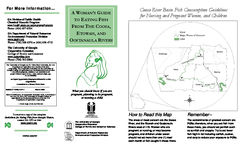For More Information...
GA Division of Public Health Chemical Hazards Program www.health.state.ga.us/programs/hazards Phone: (404) 657-6534
GA Department of Natural Resources Environmental Protection Division www.gadnr.org Phone: (706) 369-6376 or (404) 656-4713
The University of Georgia Cooperative Extension College of Family and Consumer www.gafamilies.com Phone: (706) 542-8866
The University of Georgia and Ft. Valley State University, the U.S. Department of Agriculture and counties of the state
cooperating. The Cooperative Extension and the University of Georgia College of Agricultural and Environmental Sciences offer
educational programs, assistance and materials to all people without regard to race, color, national origin, age,
sex or disability.
An Equal Opportunity Employer/Affirmative Action
Organization
Committed to a Diverse Work Force
------------------------------------------
Bulletin # FDNS-E-94-4
March 2008
------------------------------------------
Issued in furtherance of Cooperative Extension work, Acts of May 8 and June 30, 1914, The University of Georgia College of Agricultural and Environmental Sciences and the U.S. Department of Agriculture cooperating.
J. Scott Angle, Dean and Director
To receive a copy of the complete Guidelines for Eating Fish from Georgia Waters,
contact GA EPD or visit: www.gadnr.org
DHP03-095HW
A WOMAN'S GUIDE TO EATING FISH
FROM THE COOSA, ETOWAH, AND
OOSTANAULA RIVERS
Coosa River Basin Fish Consumption Guidelines for Nursing and Pregnant Women, and Children
What you should know if you are pregnant, planning to be pregnant,
or nursing a child
The University of Georgia Cooperative Extension College of Family and Consumer Sciences
Department of Natural Resources Environmental Protection Division
How to Read this Map
The areas of most concern are the Coosa River, and the Etowah and Oostanaula Rivers west of I-75. Women who are pregnant or nursing, or may become pregnant, and children under seven should not eat more than one (1) meal each month of fish caught in these rivers.
Remember--
The contaminants of greatest concern are PCBs; therefore, when you eat fish from these rivers, you should eat panfish such as sunfish and crappie. Try to eat fewer fish high in fat including catfish, sucker, and carp to reduce your exposure to PCBs.
The Benefits of Eating Fish and Seafood
Fish and seafood are excellent sources of protein, minerals, and vitamins, and play a role in maintaining a healthy, well-balanced diet. Fish is also an excellent source of Omega-3 fatty acids, which are essential for the development of a healthy baby. According to the American Heart Association, Omega-3 fatty acids in fish and seafood are also essential for good cardiovascular health for adults.
Concerns About Eating Fish and Seafood
Some fish contain contaminants, such as mercury or polychlorinated biphenyls (PCBs) that can be harmful if you eat them too often. Over time, your body may build up harmful levels of toxic chemicals that can affect your pregnancy and the health of your baby. Contaminated fish may not look, smell, or taste different, but they can still harm you and your child. Women who are or may become pregnant should contact their local health department or the Georgia Environmental Protection Division for more detailed information.
Frequently Asked Questions about Eating Fish from the Coosa River Basin
Q. Are fish from the Coosa River Basin safe to eat?
Q. What can I do to protect myself and my child from chemicals found in fish?
A. Yes, in most instances. However, some types of fish may contain contaminants that are a concern for pregnant women and young children. Women who are pregnant or nursing, or may become pregnant, and children under seven should follow the general recommendations on the map and choose fish that are likely to contain minimal amounts of contaminants.
Q. Which types of fish are most likely to have high levels of contaminants and which types are likely to have low levels?
A. The following chart lists species that typically contain higher levels of contaminants and species that typically contain lower levels. Also, keep in mind that larger fish usually have higher contaminant levels than smaller fish. For example, a 12" largemouth bass will usually be much safer to eat than a 16" largemouth bass from the same body of water.
A. Follow the suggestions below:
Eat safer types of fish and seafood
Eat a variety of fish and seafood Avoid eating fish and seafood known to have
high levels of contamination
Find safer ways to prepare fish and seafood
Before cooking, remove organs, skin and fat as shown in the diagram below
Cook the fish in a way that the fat can drip away from the fish, such as grilling
Avoid deep frying fish and seafood
Limit how much fish and seafood you eat
Nationally, the U.S. Food and Drug Administration (FDA) recommends that pregnant women should eat only a couple of servings of fish and seafood each week
Follow the guidelines in this brochure when eating locally caught fish in your area
Higher Risk Species Lower Risk Species
Largemouth Bass Hybrid Bass Striped Bass White Bass Pickerel Carp Gar Catfish Suckers
Bream Sunfish Crappie Panfish
Trout
What About Store Bought Fish?
Fish and seafood can contain trace amounts of contaminants; fish sold in stores and restaurants are no exception. However, smaller, nonpredatory fish generally contain less mercury.
Based on reports from the FDA, fish and seafood should be part of a balanced diet for pregnant women. However, some long-lived, large fish such as shark, swordfish, king mackerel, and tilefish may contain high mercury concentrations and should not be eaten. FDA recommends eating a couple of servings of fish each week, and suggests a variety of store bought fish such as shellfish, canned fish, smaller ocean fish or farm raised fish.
Generally Safe Fish to Eat
Commercial fish and seafood such as flounder, pollock, cod, salmon, shrimp, clams, scallops, oysters, mussels, and farm raised fish, such as catfish, generally are safe to eat.
